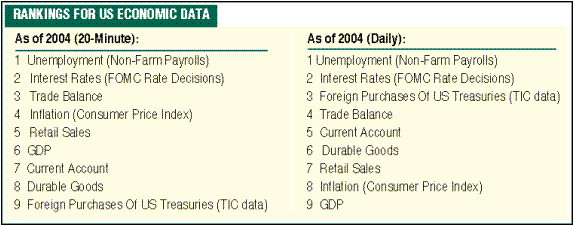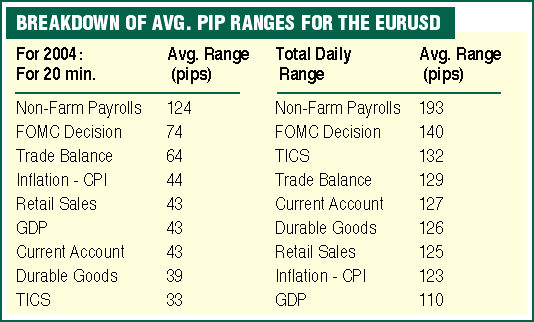Access to foreign exchange trading has opened up exciting trading options for the retail trader. You can now trade alongside corporations and institutions in a highly liquid market that is global, traded around the clock, and highly leveraged. Before jumping into this market, however, we must understand the factors that affect the forex market. With that in mind, Stocks & Commodities is introducing Forex Focus to better prepare the retail trader to participate in the currency market.
WHAT MOVES THE US DOLLAR?
Many factors are responsible, but some are more important than others.
Most speculative currency traders are technicians - that is, traders who rely solely on charting methods. However, this does not mean that fundamentals are insignificant and have no bearing on trading decisions. In fact, more and more technicians are inquiring about the expectations of the market leading up to major economic releases.
NUMBERS TO KEEP AN EYE ON
It is estimated that approximately 25% of all traders base their strategies off fundamentals, using releases such as Gross Domestic Product (GDP), employment, and Consumer Price Index (CPI) as the basis for their trading decisions. Because of this substantial influence in the market, knowing how, why, and which releases provoke the biggest response beforehand can be a profitable way by which to formulate trades.
Technical analysts can benefit from this knowledge as well and especially if they are range traders, in which case they may not want to trade on days when the greatest market moving data is expected for release. In contrast, if they are breakout traders, important release days might be the best days on which to trade. In both cases, being familiar with the market's reactions to these releases is important.
Although knowledge of these movements can be a great investment tool for any currency pairing, in this study the focus was on the economic releases of the US. The reaction of the dollar based upon these economic releases is benchmarked against the euro.
ECONOMIC DATA RANKINGS
The rankings for US economic data as seen in Figure 1 are based on an analysis of 20-minute and daily ranges. The rankings were broken up between 20-minute and daily reactions because not all economic releases are created equal (the 20-minute movements are calculated post-release). Some have the potential to move markets 100 pips or more by coming in only slightly above, below, or in line with expectations, whereas others barely cause a ripple in the markets, no matter how much forecasters may be off. Along the same lines, although some economic releases can cause sharp, immediate reactions, their effects may not last. This really depends upon sentiment and the amount of surprise in the release followed by its significance over the longer term.

Figure 1: NOT ALL ECONOMIC RELEASES ARE CREATED EQUAL. Here you see the 20-minute vs. daily rankings of US economic data as of 2004.
Contrary to popular belief, throughout the same time period, the GDP report has also become one of the lesser important economic indicators and has led to one of the smallest relative movements in the EUR/USD. One possible explanation is that GDP releases are less frequent than other data used in the study (quarterly versus monthly). In addition, GDP data is more prone to ambiguity and misinterpretation. For example, surging GDP brought about by rising exports will be positive for the home currency, while GDP growth as a result of inventory buildup may actually be negative for the dollar. The breakdowns of the average pip ranges for the EUR/usd can be seen in Figure 2.

FIGURE 2: PIP RANGES FOR THE EUR/USD. Note that the average daily range for the EURUSD in 2004 was 111 pips.
RANKINGS DO SHIFT
Although no single release can give a comprehensive idea of how an entire country's economy is performing, it is evident that some can be held as a better gauge than others by watching the effects they have on currencies. Yet the importance of economic data does change over time and is dependent upon the current state of the economy. A release that is perceived as the most important today might fall to a second- or third-tier level of significance within a few years.
This makes the market's perception of economic data extremely important. Some traders regard particular releases as more telling than others during times of different economic conditions. In 1992, for example, the US trade balance was the top market mover in terms of US economic data. Since then, the importance of the trade balance has diminished somewhat, making way for unemployment and interest rates.
Market watchers' bias concerning employment numbers continues today. With the economy still struggling to create jobs and US companies sending jobs overseas in search of a cheaper workforce, for now at least, people are very sensitive to employment numbers. Nonfarm payroll release days cause a shakeup in the market. They have the potential to move the Eur/Usd (on average) 124 pips in 20 minutes and 193 pips in a day on average.
A MATTER OF PERCEPTION
Knowing how market players perceive different economic releases is of utmost importance when trading on fundamentals or technicals. Although some releases do not seem as all-encompassing as the movements they trigger within the market, the point is that it is human psychology that is responsible. It is always exposed to the problems of media bias and current hot topics. Therefore, even though nonfarm payrolls top the list as the leading market mover, expectations and consensus values are always important factors to take into consideration.
Kathy Lien is the chief strategist of Forex Capital Markets (FXCM).
Suggested reading
Cheung, Yin-Wong, and Menzie D. Chinn [1999]. "Macroeconomic Implications
Of The Beliefs And Behavior Of Foreign Exchange Traders," National Bureau
of Economic Research: https://www.georgetown.edu/faculty/evansm1/New%20Micro/chinn.pdf.
Return to August 2005 Contents